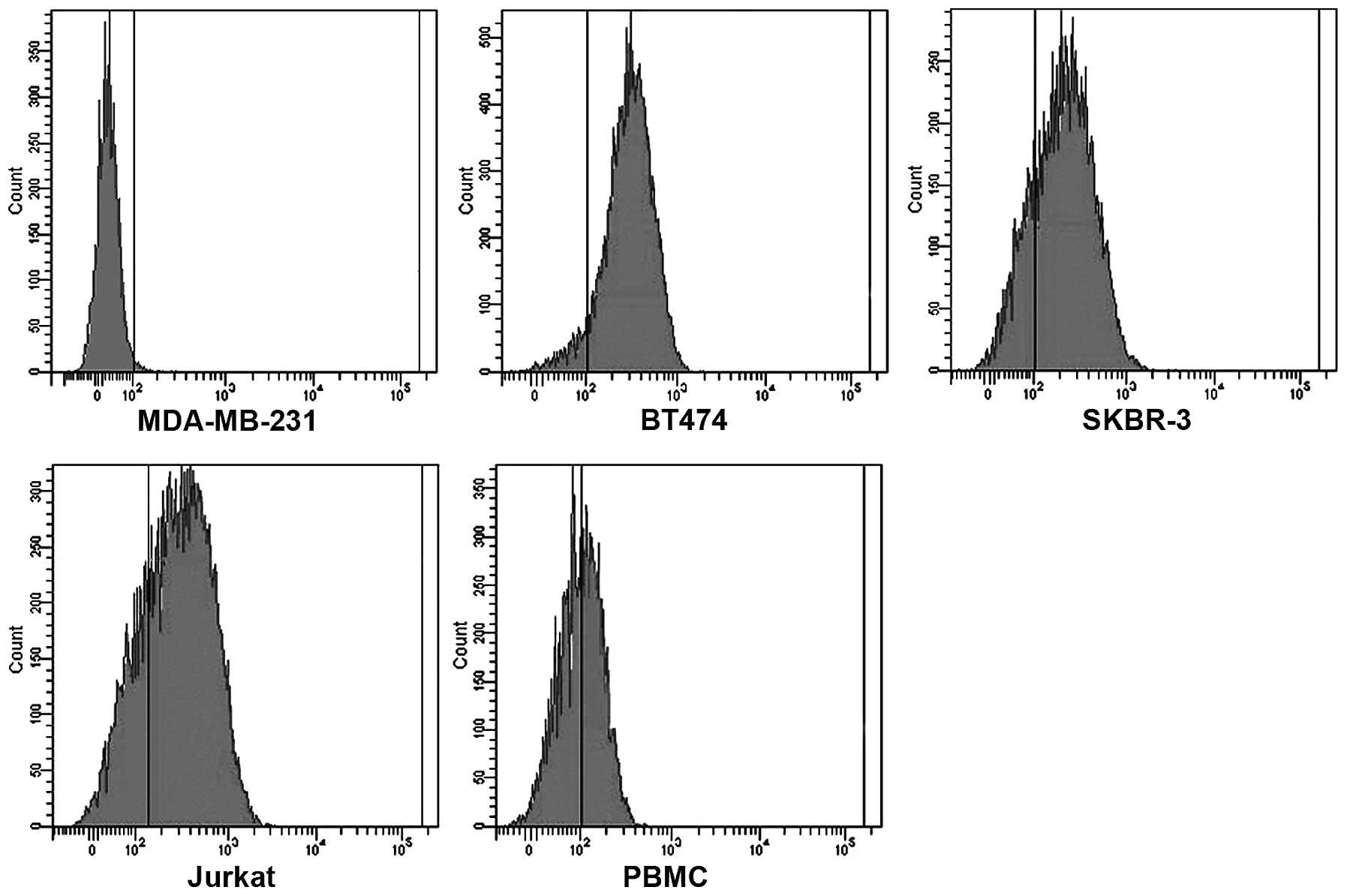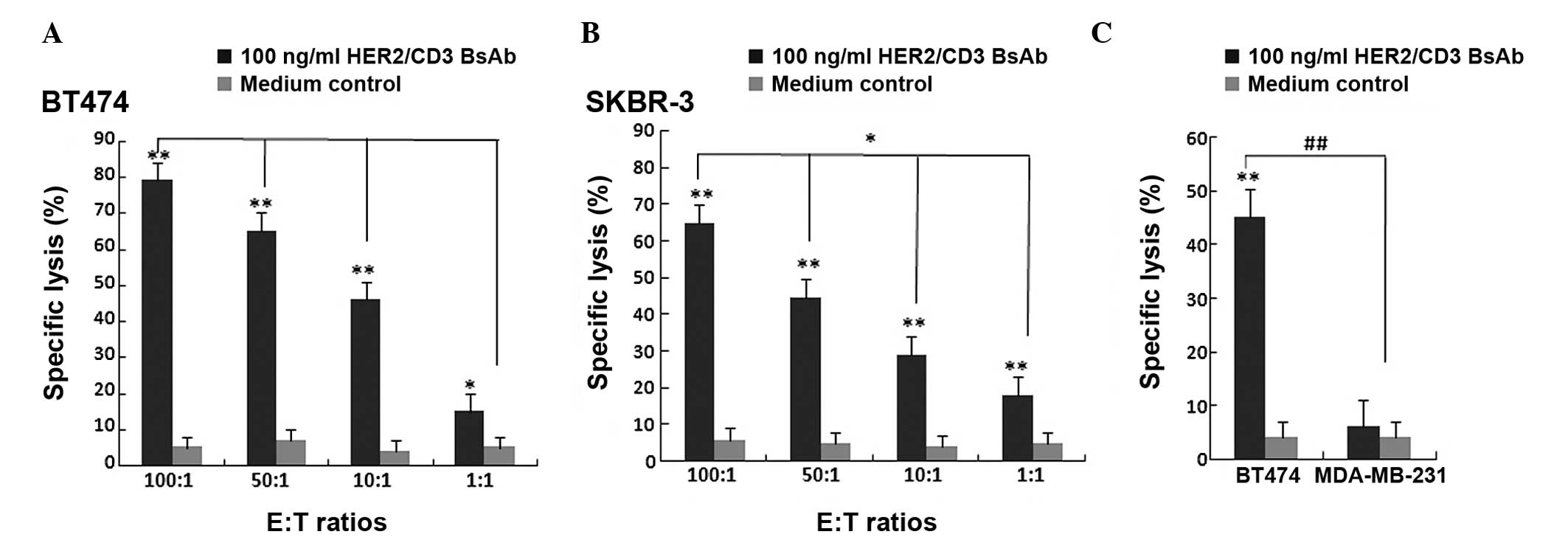|
1
|
El Saghir NS and Anderson BO: Breast
cancer early detection and resources: where in the world do we
start? Breast. 21:423–425. 2012. View Article : Google Scholar : PubMed/NCBI
|
|
2
|
Yu ZG, Jia CX, Liu LY, et al: The
prevalence and correlates of breast cancer among women in Eastern
China. PLoS One. 7:e377842012. View Article : Google Scholar : PubMed/NCBI
|
|
3
|
Oliva S, Cioffi G, Frattini S, et al:
Administration of angiotensin-converting enzyme inhibitors and
β-blockers during adjuvant trastuzumab chemotherapy for
nonmetastatic breast cancer: marker of risk or cardioprotection in
the real world? Oncologist. 17:917–924. 2012. View Article : Google Scholar :
|
|
4
|
de Hoon JP, Veeck J, Vriens BE, Calon TG,
van Engeland M and Tjan-Heijnen VC: Taxane resistance in breast
cancer: a closed HER2 circuit? Biochim Biophys Acta. 1825.197–206.
2012.
|
|
5
|
Arapantoni-Dadioti P, Valavanis C,
Gavressea T, Tzaida O, Trihia H and Lekka I: Discordant expression
of hormone receptors and HER2 in breast cancer. A retrospective
comparison of primary tumors with paired metachronous recurrences
or metastases. J BUON. 17:277–283. 2012.PubMed/NCBI
|
|
6
|
Baselga J, Bradbury I, Eidtmann H, et al:
Lapatinib with trastuzumab for HER2-positive early breast cancer
(NeoALTTO): a randomised, open-label, multicentre, phase 3 trial.
Lancet. 379:633–640. 2012. View Article : Google Scholar : PubMed/NCBI
|
|
7
|
Boulaamane L, Boutayeb S and Errihani H:
Bevacizumab based chemotherapy in first line treatment of HER2
negative metastatic breast cancer: results of a Moroccan
observational institutional study. BMC Res Notes. 5:1622012.
View Article : Google Scholar : PubMed/NCBI
|
|
8
|
Slamon DJ, Godolphin W, Jones LA, et al:
Studies of the HER-2/neu proto-oncogene in human breast and ovarian
cancer. Science. 244:707–712. 1989. View Article : Google Scholar : PubMed/NCBI
|
|
9
|
Blok EJ, Kuppen PJ, van Leeuwen JE and
Sier CF: Cytoplasmic overexpression of HER2: a key factor in
colorectal cancer. Clin Med Insights Oncol. 7:41–51. 2013.
View Article : Google Scholar : PubMed/NCBI
|
|
10
|
Conti M, Hsieh M, Park JY and Su YQ: Role
of the epidermal growth factor network in ovarian follicles. Mol
Endocrinol. 20:715–723. 2006. View Article : Google Scholar
|
|
11
|
Wolff AC, Hammond ME, Schwartz JN, et al:
American Society of Clinical Oncology/College of American
Pathologists guideline recommendations for human epidermal growth
factor receptor 2 testing in breast cancer. Arch Pathol Lab Med.
131:18–43. 2007.PubMed/NCBI
|
|
12
|
Larbouret C, Robert B, Navarro-Teulon I,
et al: In vivo therapeutic synergism of anti-epidermal growth
factor receptor and anti-HER2 monoclonal antibodies against
pancreatic carcinomas. Clin Cancer Res. 13:3356–3362. 2007.
View Article : Google Scholar : PubMed/NCBI
|
|
13
|
Burstein HJ: The distinctive nature of
HER2-positive breast cancers. N Engl J Med. 353:1652–1654. 2005.
View Article : Google Scholar : PubMed/NCBI
|
|
14
|
Bayoudh L, Afrit M, Daldoul O, et al:
Trastuzumab (herceptin) for the medical treatment of breast cancer.
Tunis Med. 90:6–12. 2012.PubMed/NCBI
|
|
15
|
Wang CX, Koay DC, Edwards A, Lu Z, Mor G,
Ocal IT and Digiovanna MP: In vitro and in vivo effects of
combination of Trastuzumab (Herceptin) and Tamoxifen in breast
cancer. Breast Cancer Res Treat. 92:251–263. 2005. View Article : Google Scholar : PubMed/NCBI
|
|
16
|
Rugo H, Brammer M, Zhang F and Lalla D:
Effect of trastuzumab on health-related quality of life in patients
with HER2-positive metastatic breast cancer: data from three
clinical trials. Clin Breast Cancer. 10:288–293. 2010. View Article : Google Scholar : PubMed/NCBI
|
|
17
|
Shepard HM, Jin P, Slamon DJ, et al:
Herceptin. Handb Exp Pharmacol. 181:183–219. 2008.
|
|
18
|
Wolf E, Hofmeister R, Kufer P, et al:
BiTEs: bispecific antibody constructs with unique anti-tumor
activity. Drug Discovery Today. 10:1237–1244. 2005. View Article : Google Scholar : PubMed/NCBI
|
|
19
|
Seimetz D, Lindhofer H and Bokemeyer C:
Development and approval of the trifunctional antibody catumaxomab
(anti-EpCAM × anti-CD3) as a targeted cancer immunotherapy. Cancer
Treat Rev. 36:458–67. 2010. View Article : Google Scholar : PubMed/NCBI
|
|
20
|
Bargou R, Leo E, Zugmaier G, et al: Tumor
regression in cancer patients by very low doses of a T
cell-engaging antibody. Science. 321:974–977. 2008. View Article : Google Scholar : PubMed/NCBI
|
|
21
|
Yamamoto K, Trad A, Baumgart A, et al: A
novel bispecific single-chain antibody for ADAM17 and CD3 induces
T-cell-mediated lysis of prostate cancer cells. Biochem J.
445:135–144. 2012. View Article : Google Scholar : PubMed/NCBI
|
|
22
|
Wu G, Fan X, Wu H, et al: Bioscreening of
phage display antibody library and expression of a humanized
single-chain variable fragment antibody against human connective
tissue growth factor (CTGF/CCN2). Biotechnol Appl Biochem.
56:95–102. 2010. View Article : Google Scholar : PubMed/NCBI
|
|
23
|
Petsch S, Gires O, Rüttinger D, Denzel S,
Lippold S, Baeuerle PA and Wolf A: Concentrations of EpCAM
ectodomain as found in sera of cancer patients do not significantly
impact redirected lysis and T-cell activation by
EpCAM/CD3-bispecific BiTE antibody MT110. MAbs. 3:31–37. 2011.
View Article : Google Scholar :
|
|
24
|
Jäger M, Schoberth A, Ruf P, et al:
Immunomonitoring results of a phase II/III study of malignant
ascites patients treated with the trifunctional antibody
catumaxomab (anti-EpCAM × anti-CD3). Cancer Res. 72:24–32. 2012.
View Article : Google Scholar
|
|
25
|
Reusch U, Sundaram M, Davol PA, et al:
Anti-CD3 anti-epidermal growth factor receptor (EGFR) bispecific
antibody redirects T-cell cytolytic activity to EGFR-positive
cancers in vitro and in an animal model. Clin Cancer Res.
12:183–190. 2006. View Article : Google Scholar : PubMed/NCBI
|
|
26
|
Kasuya K, Shimazu M, Suzuki M, Itoi T,
Aoki T and Tsuchida A: Bispecific anti-HER2 and CD16 single-chain
antibody production prolongs the use of stem cell-like cell
transplantation against HER2-overexpressing cancer. Int J Mol Med.
25:209–215. 2010.PubMed/NCBI
|
|
27
|
Stebbings R, Findlay L, Edwards C, et al:
‘Cytokine storm’ in the phase I trial of monoclonal antibody
TGN1412: better understanding the causes to improve preclinical
testing of immunotherapeutics. J Immunol. 179:3325–3331. 2007.
View Article : Google Scholar : PubMed/NCBI
|
|
28
|
McLaughlin P, Grillo-López AJ, Link BK, et
al: Rituximab chimeric anti-CD20 monoclonal antibody therapy for
relapsed indolent lymphoma: half of patients respond to a four-dose
treatment program. J Clin Oncol. 16:2825–2833. 1998.PubMed/NCBI
|
|
29
|
Finn RS and Slamon DJ: Monoclonal antibody
therapy for breast cancer: herceptin. Cancer Chemother Biol
Response Modif. 21:223–233. 2003.
|














